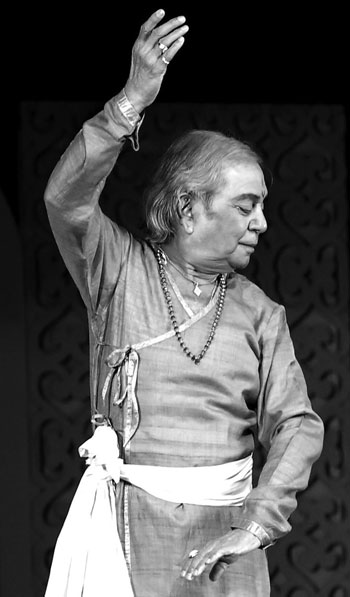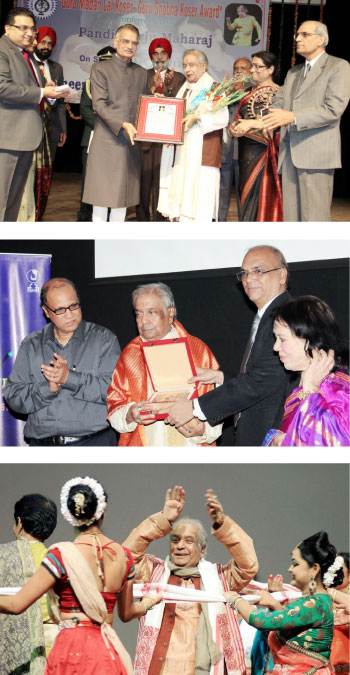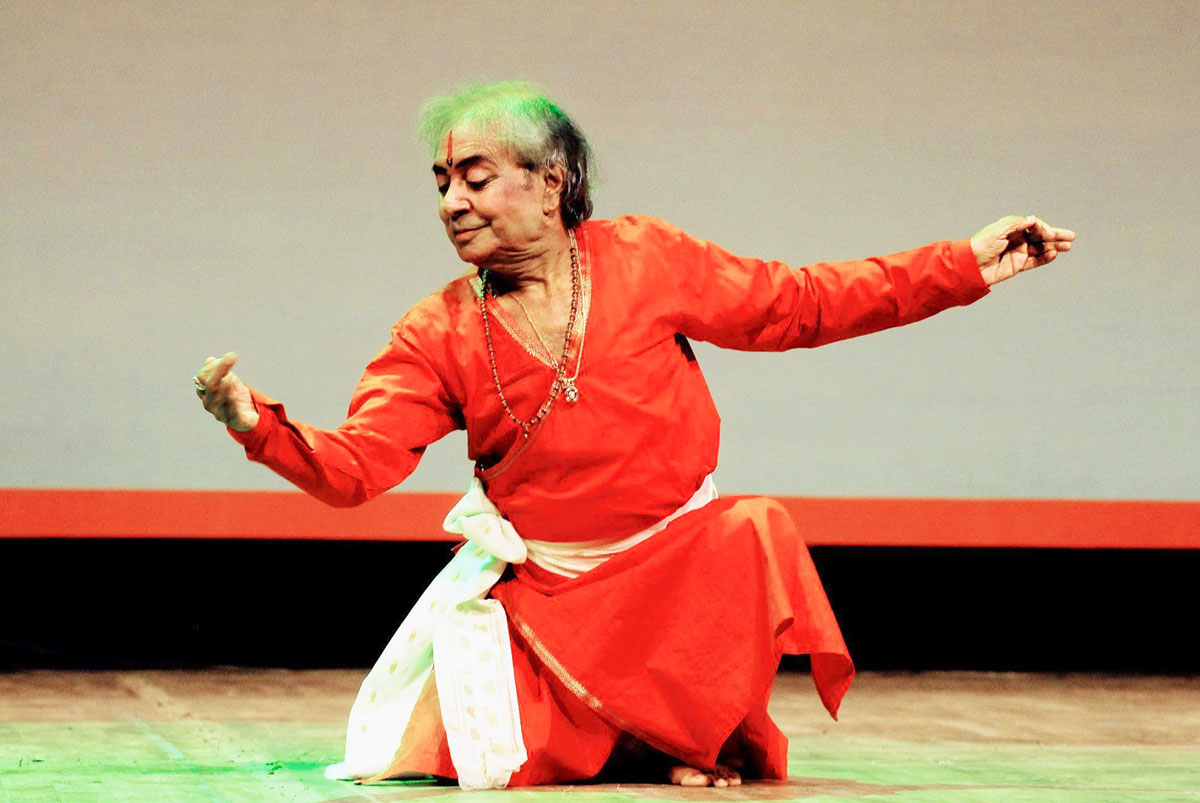Pandit Birju Maharaj “I Consider Madhuri Dixit The Best In Kathak Dancing”
One of the most respected Kathak exponents of the country, Pandit Birju Maharaj, originally known as Brijmoham Mishra, belongs to the traditional family of musicians and dancers, whose contribution towards the enrichment and propagation of Kathak dance is invaluable and spans for over generations together. A multi-faceted artiste and the recipient of some of the most prestigious awards that includes “Padma Vibhushan”,belongs to the Lucknow Kalka-Bindadin Gharana of Kathak dance and is also known as the cultural ambassador of India, In an exclusive interview with VIJAY SHANKER, Panditji talks about his journey of dance and his passionate disciple Saswati Sen.
Pa ndit Birju Maharaj is the descendant of the legendary Maharaj family of traditional musicians,dancers and teachers. Birju is the son and disciple of Acchan Maharaj and his uncles include Shambu and Lachchu Maharaj. Acchah Maharaj served as the court dancer in Raigarh princely state but on 20th May 1947 he died and Birju was barely nine years old, hence learnt Kathak later from his uncles Shambu and Lachchu Maharaj. After few years of struggle, the family moved to Delhi. Surprisingly Birju started teaching Kathak at the Sangeet Bharti in New Delhi at the age of thirteen, later at the Bhartiya Kala Kendra and finally at the Kathak Kendra,, a unit of the Sangeet Natak Akademi. At Kathak Kendra Briju’s status as a teacher and performer grew rapidly to the extent that to be a disciple of Pandit Briju Maharaj was considered the ultimate dream for any student of Kathak. His scholarly knowledge as a teacher, dancer,singer and choreographer is peerless. He has several disciples all over the world and conducts workshops in several cities too.
ndit Birju Maharaj is the descendant of the legendary Maharaj family of traditional musicians,dancers and teachers. Birju is the son and disciple of Acchan Maharaj and his uncles include Shambu and Lachchu Maharaj. Acchah Maharaj served as the court dancer in Raigarh princely state but on 20th May 1947 he died and Birju was barely nine years old, hence learnt Kathak later from his uncles Shambu and Lachchu Maharaj. After few years of struggle, the family moved to Delhi. Surprisingly Birju started teaching Kathak at the Sangeet Bharti in New Delhi at the age of thirteen, later at the Bhartiya Kala Kendra and finally at the Kathak Kendra,, a unit of the Sangeet Natak Akademi. At Kathak Kendra Briju’s status as a teacher and performer grew rapidly to the extent that to be a disciple of Pandit Briju Maharaj was considered the ultimate dream for any student of Kathak. His scholarly knowledge as a teacher, dancer,singer and choreographer is peerless. He has several disciples all over the world and conducts workshops in several cities too.
Panditji will turn 80 shortly and for the first time organized the Kalashram Kathak at the NCPA Tata theatre, in Mumbai, several dancers from different cities, including London participated and the winners in two groups of below and above 20 years of age were provided with the “Biriju Maharaj Crown”. After retirement from Kathak Kendra, Panditji established his own dance academy known as Kalashram In New Delhi and this is the first rime that Kalashram has taken the initiative to spot fresh talent. When I met Panditji in his cozy suite at the Orchid Hotel, near the Airport, the first question I asked was as to how did this idea erupt of organising a competition of this level, Panditji said “Normally it is the major cities that get lots of chances to perform, hence fresh talent from smaller towns are not recognised, Surprisngly I see some wonderful talent coming from remote areas too that shows the devotion and involvement these days children have in spite of the onslaught of the western culture”.
 Adding to this, his ardent disciple, Saswati Sen, who has performed along with him around the world and has been dancing for more than three decades says “Every year we conduct the summer workshop at Nehru Centre in Mumbai and this year we were surprised, the turnout was maximum, about 850 students but Maharaj always maintains his cool and said “koi baat nahi, ho jayaga’ and we did not let down any student as they come with such great expectations and learn with lot of passion. After the workshop they wonder where to go as we have given them only a taste of the food and not the entire meal. I feel we should have a winter workshop too as students can learn more”. Saswati Sen has had the unique privilege of doing a solo number in Satyajit Ray’s “Shatranj Ke Khiladi” in a scene with the dynamic Amjad Khan, choreographed by Maharaj.
Adding to this, his ardent disciple, Saswati Sen, who has performed along with him around the world and has been dancing for more than three decades says “Every year we conduct the summer workshop at Nehru Centre in Mumbai and this year we were surprised, the turnout was maximum, about 850 students but Maharaj always maintains his cool and said “koi baat nahi, ho jayaga’ and we did not let down any student as they come with such great expectations and learn with lot of passion. After the workshop they wonder where to go as we have given them only a taste of the food and not the entire meal. I feel we should have a winter workshop too as students can learn more”. Saswati Sen has had the unique privilege of doing a solo number in Satyajit Ray’s “Shatranj Ke Khiladi” in a scene with the dynamic Amjad Khan, choreographed by Maharaj.
Regarding choreography for films Maharaj says, “Initially I was worried as to how to do it, as the director would say let’s shoot the finale dance sequence and that would confuse me, unlike in stage shows where the complete dance is performed in one go but slowly I started learning and visualizing as to how the dance would be featured and then the music part, the vocalist would arrive separately and musicians too would be recorded separately and ultimately they would all come together and then I would listen to the music properly which would seem strange for me as in dance shows the music is recorded in advance and then I choreograph. I consider Madhuri Dixit the best and my choreography for “Devadas” has been the most satisfying”.
 Birju Maharaj adds. “Kamalahasan in “Viswaroopam” learnt Kathak from me and invited me to Chennai, he was a good student and was quite conscious about the performance and would repeatedly ask me whether he was performing properly. Moreover I must admit that Sanjay Leela Bhansali has fine sense of music and knew exactly what I wanted, hence it was a pleasure to work with him for Devdas, I must state here that in Devdas, Kathak has been pictured beautifully, enhancing the expressions and the magic of rhythm too”. After Devdas, Kathak has really become quite popular and more youngsters are taking to it. Maharaj has also sung with a commendable and soulful voice in Devdas that shows his command over Hindustani music too”.
Birju Maharaj adds. “Kamalahasan in “Viswaroopam” learnt Kathak from me and invited me to Chennai, he was a good student and was quite conscious about the performance and would repeatedly ask me whether he was performing properly. Moreover I must admit that Sanjay Leela Bhansali has fine sense of music and knew exactly what I wanted, hence it was a pleasure to work with him for Devdas, I must state here that in Devdas, Kathak has been pictured beautifully, enhancing the expressions and the magic of rhythm too”. After Devdas, Kathak has really become quite popular and more youngsters are taking to it. Maharaj has also sung with a commendable and soulful voice in Devdas that shows his command over Hindustani music too”.
Saswati and her sister Baswati were among the foremost disciples of Maharaj, Initially Saswati learnt from Reba Vidyarthi and after winning a scholarship from the department of Culture from Government of India, took advanced training from Maharaj, Saswati assists Maharaj in all his work and choreography, the most notable being “Romeo and Juliet” with music by Louis Banks, Saswati is a a devoted dancer and disciple and they share a unique bond which is true of the Guru Sishya Parampara. Baswati has married the son of Shambu Maharaj – Krishna Mohan and their daughter Eshita Mishra is also a talented dancer
Pandit Birju Maharj won the Filmfare award for best choreography for “Mohe Rang De Lal” from Bajirao Mastani 2016, National award and Tamil Nadu state film award for best choreography for Vishwaroopam(2012). Other prestigious awards include the Sangeet Natak Akademi Award, Kalidas Samman and the doctorate from Khairagarh Unversity
Lastly the legendary maestro sums up with a beautiful poetic couplet “Nirmohi Tat Kya Jane, Lehro Ki Prem Ki Basha” (How will the Detached Shore understand the romance of the waves).


